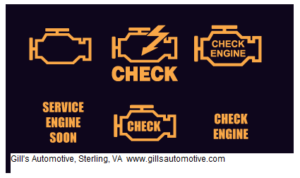Check Engine Light troubles can be a headache for a car owner, but you shouldn’t ignore the problem it indicates.
When your vehicle’s dreaded “Check Engine” light comes on, you usually feel that sinking feeling. The “Check Engine Light” is a signal from the car’s engine computer that something is wrong. It can be a very costly issue such as a bad catalytic converter, or something as minor as a loose “gas cap”. What it definitely means, though, is that you will be visiting your trusted auto repair shop to diagnose the issue.
Deciphering the Code
Do-It-Yourselfers can buy inexpensive code readers that connect to this standardized onboard diagnostics (OBD) port located under the steering column. You can then search for the code’s meaning on websites such as https://www.engine-light-help.com/. The Check Engine light can even be turned off by some code readers, however this action alone does not actually repair the underlying problem. In many cases the light will simply come back on later. Your auto mechanic has a more elaborate computer code reader that can identify the problem in a more precise manner.
Check Engine lights come in orange, yellow or amber, depending on the manufacturer. If the light begins flashing it indicates a more serious problem, such as a misfire that can quickly overheat the catalytic converter. These emissions devices operate at high temperatures to cut emissions, but can pose a fire hazard if faulty.
Don’t Ignore That Light
Statistically, 10% of all cars on the road have a Check Engine light on, and the drivers of half of these cars have ignored the light for more than three months. If your Check Engine light comes on and it’s steady rather than flashing, what do you do? The obvious answer is to get the engine checked. However, many people do nothing, perhaps fearing an expensive repair bill. Just remember, though, in order to pass your state’s vehicle inspection, you must get the light turned off. State inspections are a good motivator for dealing with the problem.
When the Check Engine Light comes on, you should first see if your gas cap is loose. A loose gas cap sends an error message to the car’s computer, reporting a leak in the vapor recovery system which is one aspect of a car’s emissions system. If the gas cap is loose, tighten it and continue driving. It may still take some time for the light to turn off.
Mixed Signals
Even with the code and its meaning in hand, do-it-yourself interpretation can be a little tricky, even if you’re mechanically inclined. Recently we had an instance where a car started running poorly and the Check Engine Light illuminated. The customer’s code reader detected a code for the Cam Angle Sensor. He thought about purchasing the sensor and installing it himself, but he didn’t. It’s a good thing because it would have been a waste of time and money. The sensor was fine. Instead the problem was mice had gotten under the hood and had chewed some of the wires leading to it.
Occasionally, the Check Engine light can come on when nothing is wrong with the car. It could be a temporary problem caused by a change in humidity or other factors. In such cases, the light should go off by itself after a short time. Gill’s Automotive will run a quick scan FREE OF CHARGE if your Check Engine Light is on and begin the process of determining what is happening with your engine. Don’t put it off… it could mean the difference between a minor repair or a very costly one down the road.
http://www.gillsautomotive.com
